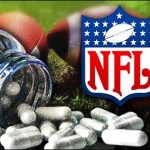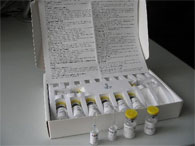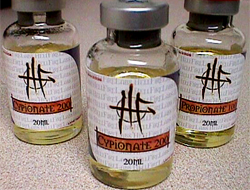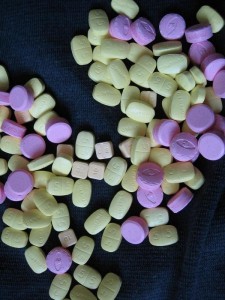 The reality was obvious: American football was beset by muscle doping and related systemic problems at all levels by the 2000s, professional, collegiate, and secondary school. The primary evidence was increasing sizes, the documented history of anabolic drugs in football [steroids from about 1960 followed by human growth hormone, clenbuterol, GHB, IGF-1, and more], and the inability to produce a valid system of testing. Football’s widespread problem of the past was confirmed even by present-day officials, rendering illogical their claim of effective prevention, given the environment’s humongous athletes with various body frames weighing in at 250 pounds and up at all levels of play.
The reality was obvious: American football was beset by muscle doping and related systemic problems at all levels by the 2000s, professional, collegiate, and secondary school. The primary evidence was increasing sizes, the documented history of anabolic drugs in football [steroids from about 1960 followed by human growth hormone, clenbuterol, GHB, IGF-1, and more], and the inability to produce a valid system of testing. Football’s widespread problem of the past was confirmed even by present-day officials, rendering illogical their claim of effective prevention, given the environment’s humongous athletes with various body frames weighing in at 250 pounds and up at all levels of play.
Urinalysis, the standard theoretical option for combating doping in football’s vast domain, was proven a failure for detection and practicality. Steroid testing, either random or scheduled, would flunk as a grade-school chemistry project, with no chance of meeting its objective because of loopholes. The null hypothesis prevailed: Conventional urinalysis could not prevent doping in football, although incessantly promoted by the sport’s athletes, coaches, organizers, doctors, employee scientists, and other associates of the game. The entire player population, preps to pros, could juice with impunity.
In addition, so-called Olympic testing was no answer for American football, despite incessant hype from officials of WADA, USADA, the USOC, and IOC. Blood testing, an elaborate, expensive, intrusive technology and protocol, was out of the question for some 15,000 school districts and about 1,000 colleges that hosted football. And expert critics lined up globally to attack the conventional testing of Olympic athletes, detailing the insurmountable faults, and a primary engineer of the technology agreed, Dr. Don Catlin. “I don’t think we’ve done anything that really ameliorates the problem; we’ve just pushed it into different areas,” Catlin said, noting that athletes and clandestine chemists always found substances and techniques to defeat screening. Drug expert Dr. Charles E. Yesalis believed designer steroids, invisible to screening, keyed many false-negative results for dopers. “You don’t know the hot drug, nor do I,” Yesalis said in 2006.  “When we find out about stuff, they’ve already gone on to the next one. Growth hormone’s use in athletics is as big a surprise as the Army Jeep. … The real secret stuff is new designer drugs.” Designer steroids were associated with notorious gurus and superstar athletes, but the drugs could reach any person through over-the-counter supplements, according to investigative reports by Amy Shipley of The Washington Post.
“When we find out about stuff, they’ve already gone on to the next one. Growth hormone’s use in athletics is as big a surprise as the Army Jeep. … The real secret stuff is new designer drugs.” Designer steroids were associated with notorious gurus and superstar athletes, but the drugs could reach any person through over-the-counter supplements, according to investigative reports by Amy Shipley of The Washington Post.
The NFL and NCAA, conducting a thin ploy amid the hot steroid politics of the mid-2000s, promised to begin rigid testing out of competition, which they originally claimed to do in 1990. “I’m not sure anyone has worked out the logistics yet, but they are supposed to be doing year-round testing,” said trainer Dave Binder, the University of New Mexico, in 2006. “They called it year-round in the past, but this is really it.” Anonymous NCAA football players, however, stated they knew of no testing in their programs during summer break. Regardless, off-season or out-of-competition testing had proved impractical for anti-doping in Olympic sports and cycling, primarily for excessive costs, logistical impossibilities, and privacy issues. “No-notice out-of-competition tests are easily dodged despite the rules,” wrote Robert Weiner, former White House drug policy spokesman, and Cael Pulitzer, sports policy analyst, in their co-commentary for The Seattle Post-Intelligencer.
A greater impracticality for prevention in football was proposed blood testing, including “bio-marking” a body’s physiology for doping signs such as fluxing levels in proteins and testosterone. Among challenges, serum analysis in America would require heavy funding, qualified personnel, and likely litigation. Moreover, experts worldwide ridiculed WADA’s purported HGH blood test, calling it questionable science. Since the 2004 Olympics, thousands of HGH tests had failed to produce one positive result.
Meanwhile, bio-identical substances, stem cell therapy, and gene transfer technology—or “gene doping” in sports parlance—promised a new wave of undetectable doping for athletes. Gene doping might have hit sports as early as 2005, a German court case revealed, when a track coach tried to purchase Repoxygen, the gene-therapy drug for boosting red blood cells in anemic patients by manufacturing extra EPO. Athletes and coaches worldwide contacted Dr. H. Lee Sweeney at Penn University, inquiring about gene transfer he employed to create “super mice” with bulging muscles and incredible performance. Scientists engineered hybrid animals such as cows with disease immunity, salmon with rapid growth, and eco-friendly pigs that produced low-phosphorus manure. “Some athletes will want to use gene doping to create super-strong muscles. Some will want to increase the supply of red blood cells so they have greater stamina,” said bio-ethicist Thomas Murray, president of The Hastings Center.
The primary process of genetic manipulation entailed the needle insertion of a plasmid composed of a virus and a gene—such as a gene for fast-twist muscle development—into a host’s particular muscle group. The virus carried the new gene through cellular walls for proper uptake. Sweeney doubted gene transfer could be detected by anti-doping in sports, but WADA claimed its scientists were making progress. A muscle biopsy would probably be the only way of finding the telltale transport virus. Sweeney planned to introduce a commercial product for dogs in 2009, gene therapy to treat muscle wasting or immobility, and he anticipated that calls from the sports world would increase. “I think the real threat is from scientists and clinicians who decide they want to make money off the athletes to make this available,” Sweeney told The London Telegraph.
plasmid composed of a virus and a gene—such as a gene for fast-twist muscle development—into a host’s particular muscle group. The virus carried the new gene through cellular walls for proper uptake. Sweeney doubted gene transfer could be detected by anti-doping in sports, but WADA claimed its scientists were making progress. A muscle biopsy would probably be the only way of finding the telltale transport virus. Sweeney planned to introduce a commercial product for dogs in 2009, gene therapy to treat muscle wasting or immobility, and he anticipated that calls from the sports world would increase. “I think the real threat is from scientists and clinicians who decide they want to make money off the athletes to make this available,” Sweeney told The London Telegraph.
More experimental substances and techniques enticed athletes and associates. “I think there’s a whole new horizon for anabolic therapies, and the potential for abuse will be exceedingly high,” said Dr. William Evans, the University of Arkansas. SARMS, or selective androgen receptor modulators, locked into steroid receptors of specific muscle groups to foster growth, and myostatin inhibitors blocked the protein that halted expansion of muscle. Prior to the Beijing Olympics, Sciencentral.com reported substances reputed to be myostatin inhibitors were sold in China, Korea, and online. Sweeney found that injecting IGF-1 into target areas stimulated specific muscles, and an injectable “HGH releaser” was on the market, Sermorelin, said to stimulate the pituitary gland for secreting more of the hormone. “MK-677,” a similar substance, stimulated production of HGH and IGF-1 in older adults. Resveratrol was another prospect for performance enhancement in athletes, as a drug said to boost endurance and lifespan in mice and rats.
So, with the undeniable failure of conventional testing, what could be done about muscle doping in American football?
The historic argument of game abolishment lingered in citizens like M.E. Davis in Missouri, angered by NFL lineman Korey Stringer’s unnecessary death of heatstroke in 2001. “It calls attention to the stupidity, callousness, inhumanity and cupidity of the ‘game’ of football and all who promote it,” Davis wrote to The Post-Dispatch. Abolishing football wasn’t widely discussed, but in the wake of BALCO’s exposure many media and policymakers believed Congress should handle the drug problem for sports. However, politicians accomplished nothing in years of wasted time, expense, and misinformation. Public patience had diminished for federal investigations into scattered individuals, even superstar athletes like Barry Bonds and Roger Clemens.
Law agencies did make progress in combating PEDs during the 2000s, but they were incapable of tackling the problem alone. Many police personnel were juicers themselves, with hundreds exposed for purchasing, distributing, or using anabolic steroids and growth hormone. In addition, the notion of teaming law enforcement with sports organizers to share information and bust athletes was badly misguided in America, given Constitutional rights and the potential for abuse by athletic organizations with historic, ongoing complicity in doping.
The overall hypocrisy and ineptitude of traditional anti-doping policies and programs led to the increasing public call for “legalizing” synthetic performance enhancement in American sports. The argument completely aligned with the culture’s prevalent value for success through virtually any means necessary, or true American ethos, and it certainly merited discussion for leagues comprised strictly of adult athletes. In addition, pro sports like the NFL already allowed anabolic drug use for select athletes, although mostly unknown to the public. The “therapeutic use exemption” in policy sanctioned tissue-building substances for diabetes and other medical conditions, including dubious “hormone deficiency” problems that doctors legally “diagnosed’ in younger men without pituitary or testicular damage. Moreover, the simple brutality of football at the pro and college levels mandated the use of painkillers and anabolic drugs, if not stimulants, yet only athletes remained at a punitive risk for exposure.
Throwing open the barn door to PED use at the prep level was untenable, however.
Weight Restrictions Based on Player Frames, Body Mass Index
The Courson Plan for the immediate prevention and future control of muscle doping in football was rather simple by composition, largely drawn from the elements of the marketplace of ideas. I was forever fond that the Courson Plan evolved in American fashion. The marketplace of ideas was the great Colonial vision for public debate, including the hearing of falsehoods. With rhetoric in the open, everyone could arrive at sound conclusions. The Courson Plan, as I would name it for the late doping expert Steve Courson, a former juicing NFL lineman, perfectly demonstrated the practice of democracy.
For eight months Steve and I mulled together ideas reported for possible prevention, and we added a few ideas ourselves. We framed a common theory in agreement, although unwritten at the time of his death, basing it on the reduction of player sizes. We capped the weights in a reasonable, equitable manner, especially for the high schools and colleges. Our big disclaimer was the method could never make football safe, much less fully eradicate doping, but it would undoubtedly improve the environment, especially for youth, at least until better ideas came long.
Given the quantifiable data of football sizes in 2008, The Courson Plan would turn back body weights while very likely reducing risks of drug use, obesity, and physical danger in competition. At least one writer was thinking in the same general approach, although separate from us: Sam Donnellon of The Philadelphia Daily News, who specifically noted the Body Mass Index for possible use. Several writers of the decade, including Dan O’Neill of The St. Louis Post-Dispatch, called for size limits in general.
Steve and I also agreed on certain components of traditional anti-doping that were compatible in their proper forms. We advocated that police should enforce the law where applicable and that anti-doping education continue based on earnest, straight talk—absent of scare tactics about known health risks and without presenting juicer suspects as so-called role models for abstinence, specifically NFL players and otherwise abnormally large athletes. We endorsed public and private funding for research and development of effective anti-doping strategies, from new testing to educational upgrades. We endorsed sound, vigilant medical precautions and care around football participation, including heart screening for every player as part of a thorough and regular checkup. Without these precautionary policies, a school, college, or pro franchise should not host the dangerous sport.
Based on our personal experiences and through decades of study, Steve and I believed anabolic substances contributed to health problems that struck each of us in the near and long term. He was almost certain that the incredible size and exertion he maintained for football contributed to his heart condition, and I believed potent injections of testosterone contributed to the hyper-extending and shredding of my right knee. Like our friend and expert collaborator Chuck Yesalis, we were convinced performance-enhancing substances were the foremost reason for the ridiculous sizes of football players beginning in the 1960s. In turn, founded on what we experienced and acquired, we believed that football sizes posed a national health menace for young males. After Steve’s death, for example, an Iowa State study determined 9 percent of Iowa prep linemen were obese by BMI standards. Such dangerous health conditions of adolescents could not be tolerated by a civil society for its institutionalized, nationalistic sport.
Therefore, The Courson Plan proposed football participation based on a BMI application. It would begin with establishing a baseline weight for every individual frame by height. Independent experts could debate limitations for the BMI regarding muscular or low-fat physiques, but allowable percentages of weight above one’s baseline—such as 189 pounds on a 6-1 frame for maximum normal—could account for discrepancies. For example, Steve was about 6-2, 230 entering college as a true genetic wonder or ultra-elite specimen fully strength-trained and athletic. He would have to employ chemicals to grow good mass from 230, where he possessed abdominal muscles and probably less than 10 percent body fat—yet he qualified as overweight on the BMI with a high risk for complications. The maximum normal or baseline weight at 6-2 was 194 pounds, with 243 the marker for entering the qualified obesity level on the scale.
 That marker weight for entering obesity in Steve’s case—or a half pound from exactly 25 percent above his normal maximum under BMI—represented a sound cutoff for the weight of any 6-2 specimen in high-school football. Colleges might set a 30 percent maximum above a body frame’s baseline, and the NFL could adopt a maximum of 35 to 40 percent above baseline, or no more than about 272 pounds on a 6-2 frame. A player could not compete weighing above these standards at any level, and close monitoring of one’s weight loss for meeting eligibility would be imperative. Obviously, a player could still juice under these guidelines, but another player could compete without drugs. In addition, a triple-pronged reduction could be realized in lowering rates of drug use, obesity, and field casualties.
That marker weight for entering obesity in Steve’s case—or a half pound from exactly 25 percent above his normal maximum under BMI—represented a sound cutoff for the weight of any 6-2 specimen in high-school football. Colleges might set a 30 percent maximum above a body frame’s baseline, and the NFL could adopt a maximum of 35 to 40 percent above baseline, or no more than about 272 pounds on a 6-2 frame. A player could not compete weighing above these standards at any level, and close monitoring of one’s weight loss for meeting eligibility would be imperative. Obviously, a player could still juice under these guidelines, but another player could compete without drugs. In addition, a triple-pronged reduction could be realized in lowering rates of drug use, obesity, and field casualties.
“People wonder why athletes take the risk [of doping], but the risk is going out on the football field in the first place,” Steve said about a month before his death, during an interview with Robert Dvorchak, The Pittsburgh Post-Gazette. “Even if you’re not taking them, steroids have had a profound impact on sports. Some juiced-up beast is trying to blast you out of the stadium. Athletes didn’t invent this stuff. We opened Pandora’s box. We’re still trying to figure out how to close it. It’s bottomless. It’s impossible to eliminate them. Let’s accept it’s inevitable. But don’t put athletes on a moral pedestal when it’s an absolute joke. Don’t speak of purity and ideals. There’s too much money invested in performance.”
Matt Chaney is a journalist, editor, teacher and publisher in Missouri. E-mail him at mattchaney@fourwallspublishing.com. For more information about his 2009 book Spiral of Denial: Muscle Doping in American Football, visit the home page at www.fourwallspublishing.com.
